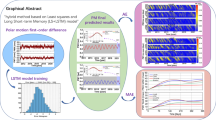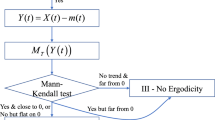Abstract
By a number of test cases using different sample numbers and sample lengths, we obtain a Radial Basis Function Neural Network (RBFNN) model that is suitable for the short-term forecast of polar motion, especially for the ultra-short-term forecast. By using the same data sample of Earth’s polar motion, this RBFNN model can achieve better short-term prediction accuracy than the least-squares+autoregressive (LS+AR) method, and better ultra-short-term prediction accuracy than the LS+AR+Kalman method. Using this model to forecast the polar motion data from January 1, 2002 to December 30, 2007 and from January 1, 2010 to December 30, 2016, respectively, experimental results show that the ultra-short-term forecast accuracy of this RBFNN model is within a precision of 3.15 and 3.08 milliseconds of arc (mas) in polar motion x direction, 2.02 and 2.04 mas in polar motion y direction; the short-term forecast accuracy of RBFNN model is within a precision of 8.83 and 8.69 mas in polar motion x direction, and 5.59 and 5.85 mas in polar motion y direction. As is stated above, this RBFNN model is well capable of forecasting the short-term of polar motion, especially the ultra-short-term.
Similar content being viewed by others
References
Akulenko L.D., Kumakshev S.A. and Markov Y.G., 2002. Motion of the Earth’s pole. Dokl. Phys., 47, 78–84.
Akyilmaz O. and Kutterer H., 2004. Prediction of Earth rotation parameters by fuzzy inference systems. J. Geodesy, 78, 82–93.
Akyilmaz O., Kutterer H., Shum C.K. and Ayan T., 2011. Fuzzy-wavelet based prediction of Earth rotation parameters. Appl. Soft. Comput., 11, 837–841.
Chao B.F., 1984. Predictability of the Earth’s polar motion. Bull. Geod., 59, 81–93.
Haykin S.S., 1998. Neural Networks: A Comprehensive Foundation (2nd Edition), Prentice Hall, Upper Saddle River, NJ.
Kalarus M., 2007. Analiza metod prognozowania parametrów orientacji przestrzennej Ziemi (Analysis of Methods of Predicting the Parameters of the Spatial Orientation of the Earth). PhD Thesis. Warsaw University of Technology Printing Office, Warsaw, Poland (in Polish).
Kalarus M., Schuh H., Kosek W., Akyilmaz O., Bizouard C., Gambis D., Gross R., Jovanovic B., Kumakshev S., Kutterer H., Cerveira P.J.M., Pasynok S. and Zotov L., 2010. Achievements of the Earth orientation parameters prediction comparison campaign. J. Geodesy, 84, 587–596.
Kosek W., McCharty D.D. and Luzum B.J., 1998. Possible improvement of Earth orientation forecast using autocovariance prediction procedures. J. Geodesy, 72, 189–199.
Kosek W., 2002. Autocovariance prediction of complex-valued polar motion time series. Adv. Space. Res., 30, 375–380.
Kosek W., Kalarus M. and Niedzielski T., 2008. Forecasting of the Earth orientation parameters-comparison of different algorithms. In: Capitaine N. (Ed.), Proceedings of the Journées 2007 “Systèmes de Référence Spatio-Temporels”. Observatoire de Paris, Paris, France, 155-158, ISBN: 978-2-901057-59-8.
Liao Y., Fang, S.C. and Nuttle H.L.W., 2003. Relaxed conditions for radial-basis function networks to be universal approximators. Neural Netw., 16, 1019–1028.
Liao D.C., Wang Q.J. and Zhou Y.H., 2012. Long-term prediction of the earth orientation parameters by the artificial neural network technique. J. Geodyn., 62, 87–92.
Moody J. and Darken C.J., 1989. Fast learning in networks of locally-tuned processing units. Neural Comput., 1, 281–294.
Niedzielski T. and Kosek W., 2008. Prediction of UT1-UTC, LOD and AAM by combination of least-squares and multivariate stochastic methods. J. Geodesy, 82, 83–92.
Orr M.J., 1996. Introduction to Radial Basis Function Networks. Technical Report. Institute for Adaptive and Neural Computation, Edinburgh University, Edinburgh, U.K.
Park J. and Sanberg I.W., 1991. Universal approximation using radial-basis-function networks. Neural Comput., 2, 246–257.
Petrov S., Brzezinski A. and Gubanov V., 1996. A stochastic model for polar motion with application to smoothing, prediction and combining. Artif. Satell., 31, 51–70.
Poggio T. and Girosi T., 1990. Networks for approximation and learning. Proc. IEEE., 78, 1481–1497.
Saha A. and Keeler J.D., 1990. Algorithms for better representation and faster learning in radial basis function networks. In: Touretzky D.S. (Ed.), Advances in Neural Information Processing Systems 2. Neural Information Processing Systems Foundation, Inc., La Jolla, CA, 482-489.
Schuh H., Ulrich M., Egger D., Müller J. and Schwegmann W., 2002. Prediction of Earth orientation parameters by artificial neural networks. J. Geodesy, 76, 247–258.
Su X.Q., Liu L.T., Houtse H. and Wang G.C., 2014. Long-term polar motion prediction using normal time-frequency transform. J. Geodesy, 88, 145–155.
Xu X.Q., Zhou Y.H. and Liao X.H., 2012. Short-term earth orientation parameters predictions by combination of the least-squares, AR model and kalman filter. J. Geodyn., 62, 83–86.
Zhang Y., Zhou Q., Sun C., Lei S.L., Liu Y.M. and Song Y., 2008. RBF neural network and ANFIS-based short-term load forecasting approach in real-time price environment. IEEE Trans. Power Syst., 23, 853–858.
Author information
Authors and Affiliations
Corresponding author
Rights and permissions
About this article
Cite this article
Wang, G., Liu, L., Tu, Y. et al. Application of the radial basis function neural network to the short term prediction of the Earth’s polar motion. Stud Geophys Geod 62, 243–254 (2018). https://doi.org/10.1007/s11200-017-0805-4
Received:
Revised:
Accepted:
Published:
Issue Date:
DOI: https://doi.org/10.1007/s11200-017-0805-4




